In the History and Genealogy of the Ancestors and Some Descendants of Stukely Westcott, Volume I (1932), Roscoe Whitman included profiles of five cousins “who achieved a place in the history of our country” under the title “Westcotts in History” (page 404), the longest of which is the essay below about General Benedict Arnold (1740/41-1801). Whitman’s article is followed by photos of a Westcott cousins visit to Arnold’s tomb in London.
A Tragic Life
There is no purpose here of attempting to condone the culpability of General Benedict Arnold, a Revolutionary soldier of the Westcott blood. However, evidence found in recent years throws a new light on his tragic life.
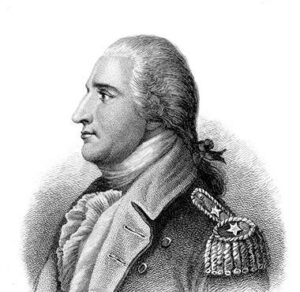
Benedict Arnold engraving by E.B. Hall in 1879
His Westcott ancestry reverts to Damaris Westcott, eldest daughter of Stukely, the Founder. Her husband was the first Benedict Arnold of Rhode Island. Their son, 3-Benedict m-Mar. 9, 1670-1, Mary Turner. Their son, 4-Benedict m-Jan. 3, 1705, Patience Coggeshall. Their son, 5-Benedict m-Nov. 8, 1733, Hannah Lathrop (King). Their son, 6-Gen. Benedict Arnold m. (1)-Feb. 27, 1767, Margaret Mansfield, who d-1775, m (2)-Apr. 8, 1779, Margaret (“Peggy”) Shippen.
Discovery of old letters of Sir Henry Clinton, an almost unknown diary of Aaron Burr, and “Peggy” Shippen’s own letters, some of them in code to Major Andre, “furnished testimony,” writes E. Irvene Haines in the New York Times Magazine of Jan. 31, 1932, “too damning for ‘Peggy’ to controvert were she alive and on trial?’
“If we read,” continues Mr. Haines, “the story of the Revolution’s greatest personal tragedy in the light of what we know now, it becomes a drama of ambitious femininity unique in American annals. It was not the game-legged, hot-tempered, disgruntled hero of Quebec and Saratoga, but the ambitious Tory girl, the spy, the tool of Clinton, who schemed so cleverly that she deceived such astute politicians as John Hancock, John Adams, Alexander Hamilton, and even Washington himself.”
“It was Clinton, acting on the suggestion of Lord George Germain, the British Colonial Secretary, who conceived the conspiracy, but it was ‘Peggy’ Shippen, with a skill and effrontery amazing in one so young, who carried it out.”
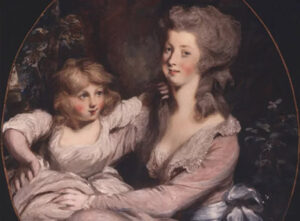
Portrait of Peggy Shippen and child by Sir Thomas Lawrence
Peggy Shippen, b-1760, was the daughter of Judge Edward Shippen, a wealthy Quaker merchant of Philadelphia, strongly pro-British and a power to be reckoned with. “From childhood,” Mr. Haines writes, “she had been reared in an atmosphere of luxury and taught to adore British uniforms and manners.”
In May, 1777, when a mere child of seventeen years, she met Major John Andre. She perhaps flirted with Andre. They were still exchanging letters when, in June, 1778, the Continentals took possession of her home city, Philadelphia, and there came along its Military Governor, Gen. Arnold. She made a friend of the susceptible and jealous Arnold, now a widower of three years. In April, 1779, they were married “to the amazement of all Philadelphia, and that same month Clinton learned that Arnold was for sale.” The remainder of the tragedy is history.
In “Vermont, Once No Man’s Land,” by the late Merritt C. Barden of West Pawlet, Vt., the author shows a picture of the only marker to Gen. Arnold — and his name does not appear upon it. This monument stands on the old Freeman farm, Saratoga battlefield at Bemis Heights, and shows an empty boot. (Some vandal has broken off the toe of the boot.) Mr. Barden writes:
“With wounded leg and horse killed, he (Arnold) led his men bravely into the thickest of the fight and won the battle that decided the destiny of the U.S.A., while General Gates lay behind a wooded hill, out of danger.”
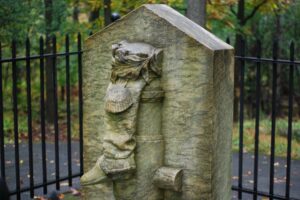
The empty boot memorial at Saratoga National Historic Park (AmusingPlanet.com)
“Washington knew that if any man could win the battle, it was Arnold, and said so. Washington sent Arnold and he won – one of the bravest men of the Revolutionary War. But through the jealousy of Gen. Gates, who got all the honor, and the Tory wife of Arnold, he became a disheartened traitor. Can we blame him? But we can forgive him who was officially abused from first to last, and his statue should stand in the vacant alcove in the monument facing the South and the battlegrounds of Bemis Heights. For it was Benedict Arnold who won that battle and decided our fate.”
When Arnold died in London twenty odd years later, it is said that his last request was that the epaulettes and sword-knot which Washington had given him, might be brought. “Let me die,” he asked, “in my old American uniform, in which I fought my battles. God forgive me for ever having put on any other.”
(Those who are interested in further studying the tragedy in the life of Gen. Arnold, should read the article “The Fatal Web Spun by Peggy Shippen,” by E. Irvine Haines, which appeared in the New York Times Magazine, Dec. 4, 1932.)
— Roscoe Whitman, History and Genealogy of the Ancestors and Some Descendants of Stukely Westcott, Volume I (1932)
Visiting Arnold’s Tomb in London
At the start of the 2019 Stukely Westcott Tour of England, a contingent of Westcott cousins visited St. Mary’s Church, Battersea along the banks of the Thames to see the tomb of General Benedict Arnold.
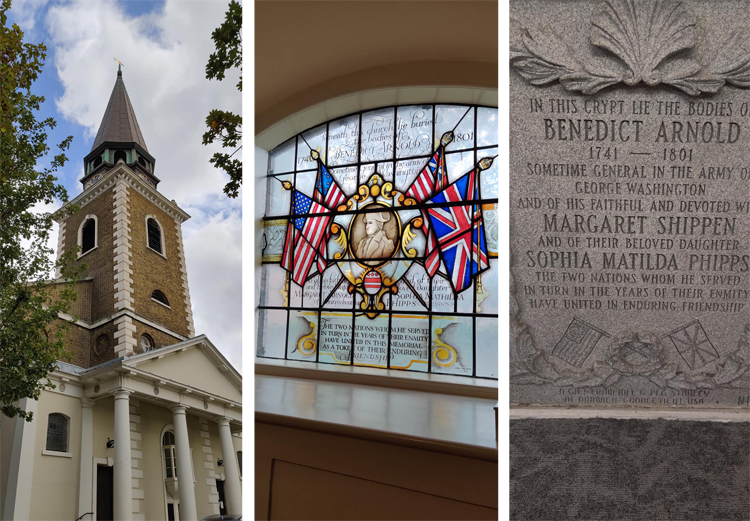
General Benedict Arnold, his second wife, Peggy Shippen, and their daughter are buried in the crypt at St. Mary’s Church, Battersea, London. Arnold is memorialized with a stained class window and a plaque (photos: David Smith)
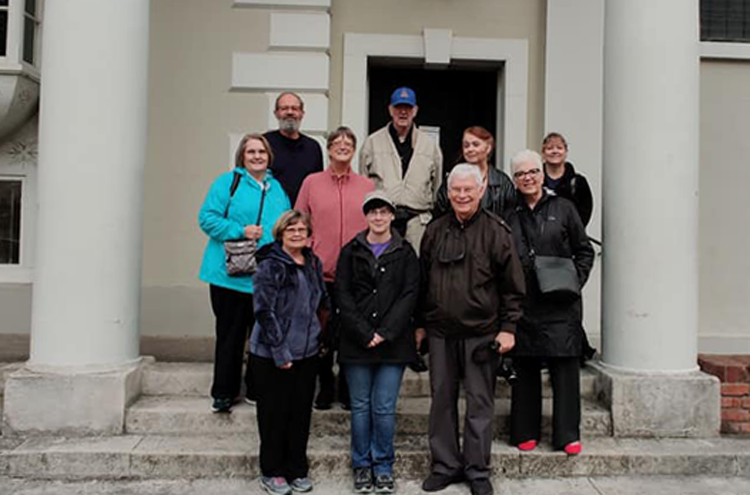
October 3, 2019. These early arrivals for the 2019 Stukely Westcott Tour of England took a quick jaunt across the Thames to visit Arnold’s tomb (from the left): Susie Campbell, David Wescott Smith, Judy Westcott Fregoe, Cathie Westcot, Jessie Fregoe, Jim Wescott, Don Wolford, Mary Pat Carroll, Susan Morris, and Jennifer Wescott Verruto.
